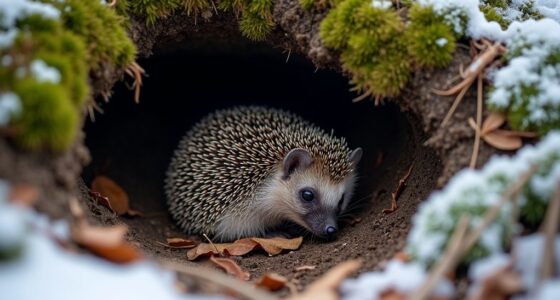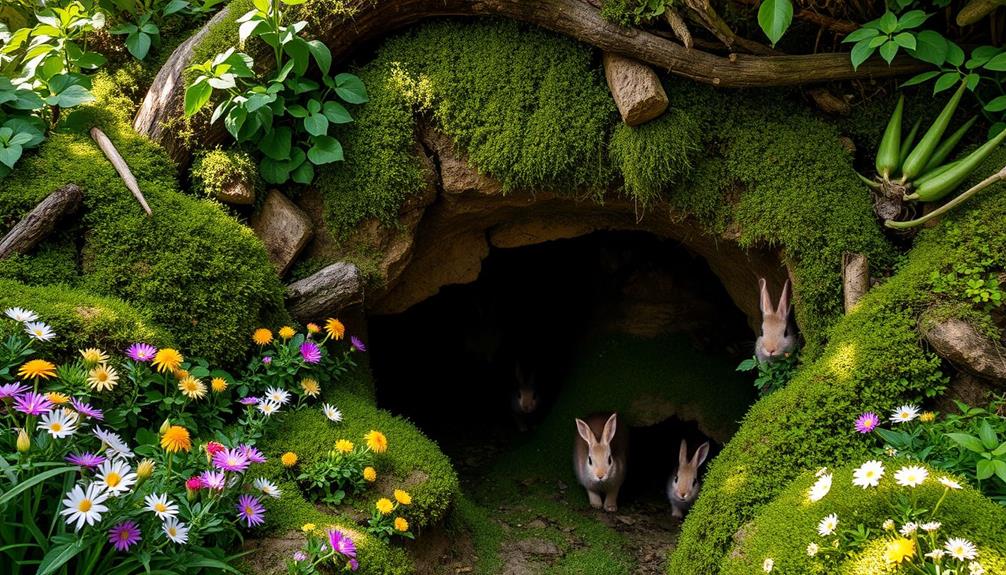To create a squirrel-friendly garden, start by providing alternative food sources like sunflower seeds and unroasted peanuts. This keeps squirrels entertained and distracted from your plants. Use squirrel-resistant bulbs and bury them deep to minimize digging. Employ physical barriers like chicken wire around your beds to protect young plants. You can also use scent-based deterrents, such as blood meal, to keep squirrels at bay. By fostering this coexistence, you enhance biodiversity and enjoy the playful antics of your backyard visitors. There's much more you can do to create a lively and harmonious garden environment.
Key Takeaways
- Create dedicated bird feeders to entertain squirrels and prevent them from damaging your plants while enjoying the wildlife.
- Incorporate squirrel-resistant plants like daffodils and allium to protect your garden while still attracting squirrels.
- Provide alternative food sources, such as sunflower seeds and unroasted peanuts, to redirect squirrels' attention away from your plants.
- Use natural materials and promote healthy plant growth to create a thriving ecosystem that supports both gardens and wildlife.
- Install physical barriers like chicken wire around garden beds to protect young plants while allowing for the presence of playful squirrels.
Coexistence Strategies With Squirrels
Creating a vibrant garden while sharing space with squirrels can be a delightful challenge. To coexist peacefully, you can implement strategies that redirect their attention from your precious plants. Since squirrels consume about a pound of food weekly, providing alternative food sources like sunflower seeds or unroasted peanuts at ground level can keep them occupied.
Additionally, using natural materials in your garden design, such as well-draining soil, can help promote healthy plant growth while minimizing the impact of local wildlife.
Setting up dedicated bird feeders filled with these treats encourages playful behavior, adding a lively atmosphere to your garden. These feeders not only entertain you but also help prevent squirrels from damaging your flowers and vegetables.
You'll find that active year-round feeding creates a buffer against potential harm to your young perennials in the spring as squirrels seek out food sources.
Incorporating trees and shrubs in your garden can further support this coexistence. These natural food sources can offer squirrels a place to forage without interfering with your plants.
Additionally, providing clean water sources like small birdbaths can enhance their experience and promote a harmonious relationship. Observing their antics can make gardening even more enjoyable for everyone, turning potential nuisances into delightful companions in your backyard.
Plant Protection Techniques

Protecting your plants from squirrels requires a blend of strategic choices and practical techniques. Start by selecting bulbs that squirrels tend to avoid, such as daffodils, allium, and fritillaries. These can be planted alongside more vulnerable options like tulips.
When planting, make sure to bury your bulbs deep in the soil. This not only makes it harder for squirrels to dig them up but also encourages healthy growth. Additionally, incorporating natural materials like stone and wood in your garden can create an inviting atmosphere that attracts other wildlife, which can help to deter squirrels from your plants elements for farmhouse dining room style.
Another effective method is to use chicken wire to cover newly planted bulbs. This allows your plants to thrive while deterring squirrels from accessing them.
Additionally, pay attention to seasonal patterns; choosing the right planting time can greatly influence squirrel activity in your garden.
Regularly remove any bulb debris, as this minimizes the attraction for squirrels searching for food. By creating a garden environment that also attracts birds and other wildlife, you'll enhance the ecosystem around your trees and plants, further discouraging squirrels.
With these techniques, you can enjoy a flourishing garden while coexisting peacefully with your backyard wildlife.
Scent-Based Deterrents

Scent-based deterrents can be an effective way to keep squirrels away from your garden. By utilizing strong odors, you can disrupt their foraging behavior and encourage a more harmonious coexistence.
Here are three scent-based deterrents you can try:
- Chicken Manure Pellets: The smell of chicken manure pellets is known to repel squirrels, making them a great addition to your garden.
- Blood Meal: This product emits a strong scent that can deter squirrels and help protect your valuable plants from their nibbling.
- Coyote Urine or Dog Urine: These natural repellents play on squirrels' territorial instincts, making them think predators are nearby, which can keep them at bay.
Physical Barriers for Protection

When it comes to safeguarding your garden from pesky squirrels, employing physical barriers can be a game changer. You can start by installing baffles on your bird feeder. These devices create a physical barrier that prevents squirrels from accessing the food, allowing birds to feed without competition.
If you want to go further, consider constructing metal cages around your feeders to limit those squirrel raids and protect your birdseed from being stolen. Additionally, using tough dog names can serve as a fun reminder of your furry friends while you work in your garden.
For your garden beds, strategically placing barriers like chicken wire can protect young plants and bulbs from being dug up or eaten. Covering newly planted bulbs with wire not only protects them during growth but also allows air and moisture to reach the plants while deterring squirrels.
Remember, squirrels need to find food and nesting sites, so being proactive with these barriers can greatly minimize wildlife activity in your garden.
Regularly checking and maintaining these physical barriers is essential to guarantee their effectiveness. By staying vigilant, you can create a protective shield around your garden, allowing you to enjoy its beauty while coexisting with nature.
Benefits of Squirrel-Friendly Gardens

Creating a squirrel-friendly garden not only helps mitigate the challenges posed by these agile critters but also brings a host of benefits to your outdoor space. By designing your garden with squirrels in mind, you can enhance biodiversity and create a thriving ecosystem.
Engaging in family activities that promote creativity, such as gardening, can also encourage children to develop a deeper appreciation for nature and wildlife family activities that promote creativity.
- Improved Biodiversity: Attracting various species supports a balanced ecosystem. Different animals contribute to the health and stability of your garden.
- Natural Food Sources: Providing squirrels with nuts, seeds, and fruits guarantees they've the nourishment they need. This, in turn, encourages other wildlife to visit, enriching your garden's habitat.
- Pest Control: Squirrels serve as natural pest controllers, munching on insects and helping maintain a healthy garden. Their presence can reduce the need for chemical pesticides.
In addition to these benefits, incorporating squirrel-friendly elements like feeders and nesting boxes creates an enjoyable environment for both you and the critters.
Watching playful squirrels can improve the aesthetics of your outdoor space and entertain your family. By embracing a squirrel-friendly approach, you're fostering a lively, diverse, and sustainable garden.
Frequently Asked Questions
How to Coexist With Squirrels?
To coexist with squirrels, you can create feeding stations, use barriers to protect plants, and implement scent deterrents. Encouraging natural habitats and limiting competition for food helps maintain harmony between you and these playful animals.
How Do I Make My Backyard Squirrel Friendly?
To make your backyard squirrel-friendly, set up feeders with sunflower seeds, plant non-preferred bulbs, and create brush piles for shelter. Deep planting and using chicken wire can help protect your favorite plants from squirrels.
What Plants Do Squirrels Hate the Most?
Think of your garden as a fortress. To keep squirrels at bay, plant daffodils, allium, and marigolds. Incorporating strong herbs like rosemary and bitter foliage can also make your garden unappealing to these critters.
How to Live in Harmony With Squirrels?
To live in harmony with squirrels, provide alternative food sources, install dedicated feeders, and use scent deterrents. Plant non-preferred bulbs, and enjoy observing their antics—this fosters a balanced relationship with these playful creatures.
Conclusion
By embracing squirrel-friendly garden ideas, you not only create a thriving habitat but also enjoy the company of these playful critters. Did you know that a single squirrel can bury up to 25 acorns in a day? Imagine the joy of watching them scurry around, hiding their treasures! With the right coexistence strategies, you can protect your plants while fostering a lively ecosystem in your backyard. It's a win-win for both you and your furry neighbors!










